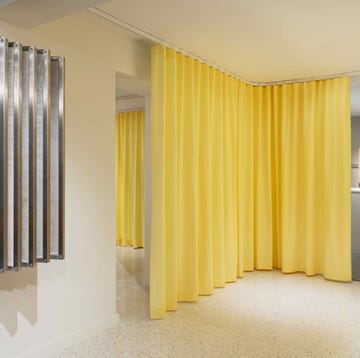Homo sapiens and linen go way back, at least as far, in fact, as the Upper Paleolithic. Archaeologists examining the soil of the Dzudzuana Cave in the Caucasus in modern-day Georgia, occupied around 35,000 years ago, found microscopic traces of linen thread that had been dyed myriad colours, including turquoise, black and pink. Linen textiles have also been unearthed at ancient sites around the Middle East and Egypt; they are mentioned in the Bible.
In fact, it’s likely that linen was the first textile ever created, paving the way not only for all the other fabrics created since, but for entire convulsions of human civilisation and technological development.
Like cotton and hemp, linen is made from a plant; in this case flax or linseed, a leggy plant with slender leaves and pretty blue flowers. Originally wild, flax has been cultivated for thousands of years. The part of the plant used to make textiles is within the stem, which contains the smooth, almost pearlescent bast fibres.
What's everyone reading?
Extracting them takes patience and skill. Firstly, the plants need to be harvested at the right time: too young and the fibres will be short and weak; too old and they’ll be coarse and tough, useful for string and rope, but not for finer cloth. Once the fibres have been extracted and combed, they can be spun, then woven. The finished articles soften with use and washing, are supremely breathable, feel cool to the touch because they naturally conduct heat, and are durable. It’s no accident that we’ve been using linen since the Stone Age.
Today, the fabric is often pigeonholed as an informal, summery textile, but the truth is that it’s extremely versatile. It can be blended with others – cotton, wool, silk and synthetics – to achieve particular properties, for example making it less likely to crease, but pure linen has ample charms, too. In fact, the chances are that you already have linen or linen-blend fabrics at home, whether as bed sheets, sofa covers or curtains. Because it’s so useful, the biggest problem may be which linen fabric to choose.
Purists will undoubtedly be drawn to ‘Ruskin’ from Morris & Co, a sumptuous woven fabric that comes in a rainbow of 30 different colours, from ivory to ink. Those hankering for floral prints might prefer ‘Sanganeri’ or ‘Casterta Paisley’ from Zoffany, or House of Hackney’s ‘Artemis’ embroidered fabric. For something more contemporary, try the riotous ‘Zig Zag Linen’ from Liberty. It seems the world’s centuries-long love of linen is still going strong.















